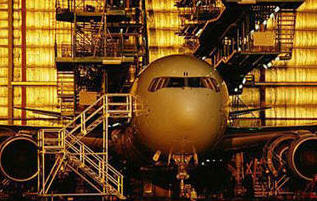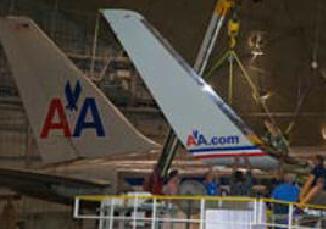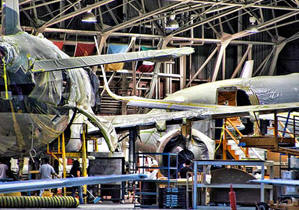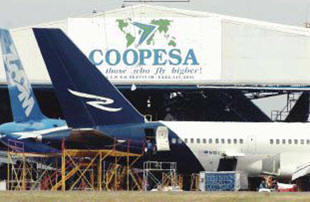|
|||||||||||||||||
|
|
|
|||
|
By |
||||
 |
March 21, 2011 - There is no question airlines have been struggling financially over the last ten years. Many over the years have blamed organized labor for being inflexible and unwilling to lower costs.
Unfortunately, in a knee jerk response in an attempt to
lower costs, many airlines have outsourced thousands of
high skilled jobs to aircraft maintenance repair
companies that are not tightly regulated or inspected by
the Federal Aviation Administration (FAA) as those
maintenance divisions run by the air carriers
themselves.
For example, in 1999 American, United, Northwest, US Airways, Delta, TWA, and Continental all performed the overwhelming majority of their aircraft maintenance work in-house. |
|||
|
Regional
airlines also kept a large portion of their work internal and
within the
A
significant amount of wide body aircraft are currently being
sent to
In the
latest OIG report, out of eight major airline FAA inspection
offices in the Each year the problem of inadequate oversight, strained government resources, and lack of consistent application of standards may put passengers at risk. At American Airlines, the TWU is resisting the industry wide outsourcing trend. Other companies have outsourced, while some airlines along with their Unions representing the workers were unwilling to look for solutions to preserve these jobs. |
||||
|
The TWU Membership
has worked to find unique ways to lower the costs of keeping work
in-house while maintaining high quality workmanship. At the same time,
the AFL-CIO Transportation Trades Department continues to pursue
legislation to hold all aircraft repair stations and airlines to a
uniform standard at the federal level. The standard of safety must be
equal for all operators, regardless if they are
This report seeks
to enlighten each person who flies as to whether he or she can be sure
the aircraft carrying them is being maintained to the highest standards.
Can you safely say the aircraft you?re flying on is maintained by people
who have under gone thorough security background checks, drug screening,
training, and can understand the maintenance manuals they are using? If
you fly American Airlines you can rest assured, TWU represented aviation
maintenance professionals are hard at work maintaining your aircraft to
the highest standards.
Many airlines have
responded to the need to cut costs by cutting wages, reducing benefits,
eliminating pensions along with outsourcing in-house aircraft repair,
resulting in massive job losses. Outsourcing aircraft repair has to be
the biggest concern to the traveling public because the FAA lacks the
resources, or a well structured oversight system to adequately ensure
aircraft maintenance is done properly.
Labor Unions are
not the only organizations raising concerns about this fact -- the U.S.
Office of the Inspector General (OIG) has repeatedly raised this issue
uring the last decade. Unfortunately, to date, a majority of the serious
safety issues raised by the OIG have not been addressed; several
critical safety issues raised are seven years old.
On another serious
note, what is the standard for personnel working on aircraft when the
aircraft repair is outsourced to a repair station?
The FAA does have
the ability to perform inspections overseas; however, the number of FAA
Inspectors is woefully insufficient. Many facilities outside the
This report seeks
to inform people about the need to take a very hard look at the system
in place for ensuring the safest possible transportation system for all
whom fly. Transport Workers Union Members are some of the most
experienced, well-trained professionals in the aviation world. Organized
labor did not create the aviation maintenance rules and regulations, but
we have worked to make sure these rules are clear, are applied
reasonably, and uniformly.
Prior to 2001, the
majority of The term ?gold plate? was used in the industry for their aircraft since in-house employees took ?pride of ownership.? Training was conducted consistently and often, the vast majority of aircraft maintenance technicians were FAA licensed, drug tested, and FAA inspectors would show up frequently to ensure proper compliance with safety regulations.
This all radically
changed with the wave of bankruptcies that occurred early on in the
first half of the last decade. United, Delta, and US Airways, to name a
few, gutted labor agreements, pay and benefits were slashed. Most
airlines sent a major portion and in some cases all -- of airframe
overhaul to outside providers of maintenance.
There is one way
to ensure your aircraft has been maintained in the U.S. by trained,
qualified, background checked, drug tested, experienced professional FAA
licensed mechanics. At American Airlines, TWU Members have worked hard
to ensure every plane is maintained to the highest possible standards
set by the FAA. In many cases, AA goes above and beyond to ensure every
aircraft is safe and reliable.
At American
Airlines overhaul bases in
There is a
language barrier problem in these operations. Large numbers of employees
at these foreign facilities do not speak English. This wouldn?t be a
problem except the international language of aviation is English. Many
of these foreign facilities do not translate the maintenance manuals and
paperwork into the workers? native language, but instead require one of
the FAA licensed mechanics to translate. You could imagine how hard it
would be at a facility like AMECO where one mechanic is responsible for
500 unlicensed mechanics.
The Transport
Workers Union and American Airlines have collaborated to find innovative
ways to control and lower cost, obtain high quality, and keep highly
skilled jobs in
For example,
management and mechanics at United and Northwest decided to fight any
type of change and ended up with catastrophic sacrifices. At United,
airframe overhaul was substantially outsourced resulting in a reduction
of more than 50% in the mechanic and related workforce.
The end result at
Northwest was even worse. The
In the end, 6,000
aircraft mechanics lost their jobs and all aircraft maintenance work was
outsourced except for two stations ?
At Southwest, the
most profitable airline of major passenger carriers, the outsourcing
problem persists. Work restricted under an earlier agreement negotiated
by a predecessor Union to only North American facilities is now being
sent to Aeroman in
Aircraft Mechanic
positions at Southwest are now capped at 2.75 per aircraft, without
regard to whether the work can be completed more effectively by in-house
aircraft mechanics.
The mass
outsourcing of aircraft overhaul maintenance and the resulting closure
of a majority of domestic aircraft maintenance facilities operated by
U.S carriers has impacted all mechanic and related personnel. Highly
skilled facility and automotive technicians, along with their
experienced and capable support personnel, have been furloughed
numbering into the thousands. Properties they maintained have been
shuttered or sold. Most air carriers have now completely discarded this
crucial function to limit their maintenance operations to the bare
minimum.
Many observers
have argued Unions are the cause of all the job, wage, and benefit
losses at airlines mentioned. That would not be a true statement.
Non-Union Delta airlines made the same choice to outsource aircraft
maintenance work by substantially shedding airframe overhaul repair. The
driving factor in the decision to outsource was obviously the reduced
exposure to
? TIMCO ?
maintenance contractor for United, Delta, and US Airways ? was found to
have multiple employees working on critical aviation maintenance
structures that had falsified immigration documents. The employees were
caught in 2005 during a federal investigation. ? On November 18, 2009 the Transportation Security Administration (TSA) issued a Notice of Proposed Rule Making (NPRM) to address the significant gaps on security that exist at repair stations. Currently those employees that do not have access to the airfield operations area do not have to undergo security background checks; however, they are allowed to work on safety sensitive structure, engines, and components.
? In 2003 at a
? In January 2011,
FAA has proposed a $1.025M fine of ST Aero for hiring 90 repair station
employees at its
The work they
performed has not been moved to facilities with equal skill and
capabilities. Overhaul work for United, US Airways, and Delta is now
done in countries like China, El Salvador, Singapore, and Mexico, to
name a few, and the standard of work being performed by these facilities
is often not of acceptable quality. For example, read the following
issues that have come up in recent years:
? US Airways
mechanics found incidents of door components installed backwards and
crossed wires for critical engine instrumentation. All this work was
conducted at Aeroman in
During a NPR
interview Aeroman mechanics stated that many did not speak English even
though the manuals are not in Spanish.
? The OIG stated
in their 2003 report that of the repair stations visited, 38 percent did
not maintain training files for supervisory personnel that were
overseeing the work performed.
? Aeroman
mechanics say managers kept pressuring them to fix the planes faster.
For instance, if there's rust on a metal beam, but it's just a little
over tolerance, "the supervisor says, 'Oh, just leave it like that,' "
the mechanic says, through an interpreter.? 'There's no need to repair
it.
? The 2003 OIG
report AV-2003-047 detailed an incident (airline de-identified) of an
aircraft operated by a
While some labor
Unions seem to have given up on the fight10, the TWU (AA Mechanics
Union) continues to push for uniform standards for all aircraft
maintenance facilities. The TWU continues to lobby for stricter
standards for all FAA licensed repair stations. The issue is not
protectionism, but safety, and the need for a single standard of safety.
At the same time
air travel was becoming more common place, aviation technology improved.
The aircraft became safer, but they also became more complex to
maintain. Composite materials, advanced avionics, and new maintenance
information technology are now the rule instead of the exception. There
has also been a shift in how aviation maintenance is being monitored for
compliance with the safety regulations.
The ATOS system in
place was still evolving and the major financial crisis at nearly all
the airlines was unprecedented. The FAA did not have the resources to
meet the demand for increased inspections that were needed as the
problems got worse. United, US Airways, and Delta dropped most, and, in
some cases, all airframe overhaul at Northwest they went even further by
outsourcing all airframe and engine overhaul along with line maintenance
at all but two cities. Outsourcers of aircraft maintenance promised
airlines they could handle the new influx of work.
The FAA had
implemented ATOS on airlines that performed most of their maintenance
in-house, but this changed overnight. Safety oversight was now severely
strained and the financially strapped airlines decided costs needed to
be lowered further. Maintenance on nearly all wide body aircraft and
some narrow body aircraft was moved to foreign repair stations.
The FAA did not
have the inspection staff in place to cover this occurrence and airlines
and the FAA did not move to adapt ATOS to properly oversee the change in
work responsibility. The OIG had already signaled concerns about
oversight and now the issues were magnified many fold.
? The NTSB12in
1997 recommended to the FAA that it 1) ensure that passenger aircraft
maintenance receives the same level of FAA oversight, regardless of
whether it was performed in-house or by repair stations 2) review the
workload of inspectors assigned oversight responsibility for repair
stations to ensure those inspectors have sufficient time and resources
to perform surveillance.
? In the 2003 OIG
report AV-2003-047, it was noted that the FAA inspected one major
? Also in the OIG
report AV-2003-047, the report stated that ??the FAA has no mechanism in
place to obtain information on how much work is outsourced, domestically
or overseas. FAA inspectors believe it is not part of their oversight
responsibility to track this information.?
? FAA inspector
staffing and budget problems are hampering the oversight process. At
five of the nine major air carriers reviewed, the OIG was told they
could not perform their tasks due to the constraints of the current
budget. One inspector was so constrained the office was only able to
inspect 16% of one carrier?s substantial maintenance providers.
? The OIG reported
again in 2010 that the FAA was not able to get their required
inspections accomplished. During the period of FY2005 and FY2009,
inspectors at 8 major
? The FAA is not
following its own risk assessment guidance. During the merger of
Northwest and Delta the FAA rated neither of those airlines as a higher
risk even though the FAA lists ?Merger or Takeover? as an area of
increased risk and stepped up inspections were required.
? During the
period of FY2002 to FY2009 the US Airways inspection office completed
slightly less than 25% of its inspection workload. US Airways outsourced
60% of their total maintenance spend in FY2009.
One can easily
tell the problems and issues are well documented; however, the FAA has
not caught up to the changing airline environment. There are
insufficient inspectors for foreign repair stations and there is no way
they can adequately and uniformly ensure the same level of compliance at
all repair stations foreign and domestic.
The FAA clearly
has work to do to ensure airline passengers can be assured their
aircraft has been maintained to the same standard of quality and
compliance. Under the current system of controls and oversight, unless a
passenger is flying on American Airlines, the chances are the aircraft
they?re on was maintained by a repair station which may or may not have
been inspected within the last five years.
Is There A
Solution? How Can The Public Be Reassured Their Aircraft Is As Safe As
Possible?
Under the current
regulatory system there are no assurances. There is hope, the TWU, the
AFL-CIO Transportation Trades Department and its affiliates have been
working together to get the aviation safety system working right. The
The TWU through
the Transportation Trades Department has advocated for stricter
legislation for drug testing, uniform standards of repair station
licensing, and security background checks for anyone who work?s on an
aircraft, engines, and components regardless of whether or not the
employee is on or off the airport area of operations.
While many
lobbyists for independent repair stations and Corporation?s would say
Unions want to protect their member?s jobs at the expense of affordable
air travel, consistent uniform safety standards are the best possible
protection for the traveling public. The following reforms are necessary
to achieve this standard;
? Require that all
maintenance on all
? Require, as a
condition of FAA certification, all repair stations meet the same
standards. This would include, but not be limited to, drug and alcohol
testing and Part 65 aircraft mechanic certification, background checks
etc.
? Reconfigure FAA
inspection and oversight to place the greatest scrutiny on those repair
stations whose audits determine to pose the greatest risk to safety and
security.
? Require, as a
condition of FAA-certification, all repair stations be subject to
unannounced FAA inspections. The FAA shall be prohibited from certifying
any repair station in any countries that prohibit unannounced
inspections and shall immediately revoke any existing certifications in
these countries.
While these points
are merely a short list, there are legislative actions already moving
forward at this time. The FAA Reauthorization Bill has been discussed
and reworked but has yet to be voted on by both houses of Congress. The
TSA has also issued a Notice of Proposed Rule Making on repair station
security that needs to move forward so passengers can be assured the
work done on the aircraft was done by people who have been thoroughly
screened. The traveling public has a right to demand safe air travel and
the government?s role must be to ensure that safety is not compromised.
Leveling the
Playing Field - A TWU Priority- The TWU understands the obstacles labor
faced during the past decade. There have been pay concessions, loss of
pensions, huge job loss at a majority of the air carriers and
significantly more expensive health care.
As the largest
single organized aircraft maintenance labor group in the
We are now working
to set a clear direction with goals and campaigns developed by the
AFL-CIO Transportation Trades Department. In addition, we are working
with our new labor Coalitions, the (IBT) International Brotherhood of
Teamsters and (CAPA) Coalition of Airline Pilots along with the (APA)
Allied Pilots Association and (APFA) Association of Professional Flight
Attendants at American, to persuade Congress, the FAA, and the
Department of Transportation to preclude substandard aircraft
maintenance by requiring the proper oversight by the FAA and other
greatly needed safety and security measures.
All this to ensure
the
On Capitol Hill,
concerned legislators have been working to correct the problems with the
current Federal Aviation Regulations. The FAA Air Transportation and
Safety Improvement Act (S223) passed the Senate in February 2011, but
with several anti-worker amendments. The new bill has been weakened
significantly however.
Foreign repair
station inspections have been reduced to ?risk-based? versus required
and the U.S. Secretary of State and Secretary of Transportation only
?request? not require drug and alcohol standards for foreign repair
stations that work on the The risk-based system is flawed as noted in the OIG 2008 and 2010 reports16 and until the system is corrected, the FAA should be conducting the inspections. The House is moving forward with their version of the bill (HR658) which is more anti-worker than the Senate bill and seeks to liberalize inspections, drug testing, and background checks even further.
There is even an
amendment to the bill seeks to repeal the changes by the National
Mediation Board (NMB) that make Union organizing election rules more
reasonable. The bill should focus on improving aviation safety and
security not partisan politics or business lobbyists who want profits
with no consideration to for the private citizen?s well-being.
Enough is enough!
The public, as well as all aviation professionals should be extremely
concerned. The government must determine an acceptable set of standards
to ensure the traveling public?s safety. If drug and alcohol testing,
security background checks, and frequent compliance inspections by the
FAA is not important enough to do abroad, then why do it at home in the
U.S. to airline owned aircraft maintenance repair facilities? The answer is simple, any reasonable person wants a drug free, fully screened, and closely monitored aircraft mechanic responsible for working on their aircraft as it flies at 30,000 feet at over 500 MPH. Every American should be appalled at the compromises being made, while other federal watchdog agencies like the Inspector General and NTSB have pointed out for over ten years specific issues must be addressed.
What can you do?
Contact your Representatives and Senators today and let them know your
safety and security is important and to pass the bills S223 and HR658
without the new amendments. The current bill with amendments weakens the
FAA?s ability to ensure acceptable standards of safety and security. Act
now!
At the bargaining
table, the TWU is working hard to ensure the Membership we represent
reaps the benefits of their hard work, financial sacrifices, and
increased productivity. This goal will be achieved through a unified
effort of all TWU brothers and sisters.
At AA these
contract negotiations are our number one priority, no matter how
frustrated we are with the process dictated by the Railway Labor Act and
the extended time we have been in mediation/negotiations. We must
remember at this critical time to respect one another?s opinion. At the
same time make sure the inevitable and necessary debate among ourselves
is based on accurate information and fact rather than innuendo, and
motivated by a true desire to move the Membership forward.
In closing, no
matter how daunting the task before us may seem, no matter how this
industry may have betrayed our thoughts and dreams of how we envisioned
our careers, no matter how many times we hear from people that have not
been in the arena and claim to have all the answers, it is best to
reflect back to some of the best advice provided by the founder of our
Union: |
||||||||||||||||||||||||||||||||||||||||||||||||||||||||||||||||||||||||
|
|
||||||||||||||||||||||||||||||||||||||||||||||||||||||||||||||||||||||||
| ?AvStop
Online Magazine
Contact
Us
Return To News
|
||||||||||||||||||||||||||||||||||||||||||||||||||||||||||||||||||||||||
|
||||||||||||||||||||||||||||||||||||||||||||||||||||||||||||||||||||||||









